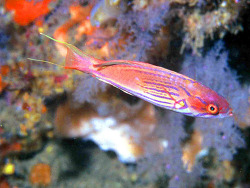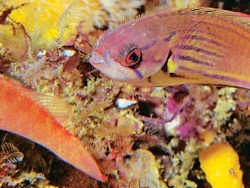Info
Randall & Harmelin-Vivien, 1977
Very special thanks to Hiroyuki Tanaka, Japan, who allowed us to use his pictures!
Distribution:
Western Indian Ocean: known from three specimens from off Madagascar. Reported from the Comoro Islands.
Biology:
Found in the outer reef slope of barrier reefs.
Classification: Biota > Animalia (Kingdom) > Chordata (Phylum) > Vertebrata (Subphylum) > Gnathostomata (Superclass) > Pisces (Superclass) > Actinopteri (Class) > Perciformes (Order) > Labroidei (Suborder) > Labridae (Family) > Paracheilinus (Genus) > Paracheilinus hemitaeniatus (Species)
Jumping guard
A jumping guard prevents (nocturnal) fish from jumping out.
Wrasses, blennies, hawkfishs and gobies jump out of an unprotected tank in fright if their night rest is disturbed, unfortunately these jumpers are found dried up in the morning on carpets, glass edges or later behind the tank.
https://www.korallenriff.de/en/article/1925_5_Jump_Protection_Solutions_for_Fish_in_the_Aquarium__5_Net_Covers.html
A small night light also helps, as it provides the fish with a means of orientation in the dark!
Very special thanks to Hiroyuki Tanaka, Japan, who allowed us to use his pictures!
Distribution:
Western Indian Ocean: known from three specimens from off Madagascar. Reported from the Comoro Islands.
Biology:
Found in the outer reef slope of barrier reefs.
Classification: Biota > Animalia (Kingdom) > Chordata (Phylum) > Vertebrata (Subphylum) > Gnathostomata (Superclass) > Pisces (Superclass) > Actinopteri (Class) > Perciformes (Order) > Labroidei (Suborder) > Labridae (Family) > Paracheilinus (Genus) > Paracheilinus hemitaeniatus (Species)
Jumping guard
A jumping guard prevents (nocturnal) fish from jumping out.
Wrasses, blennies, hawkfishs and gobies jump out of an unprotected tank in fright if their night rest is disturbed, unfortunately these jumpers are found dried up in the morning on carpets, glass edges or later behind the tank.
https://www.korallenriff.de/en/article/1925_5_Jump_Protection_Solutions_for_Fish_in_the_Aquarium__5_Net_Covers.html
A small night light also helps, as it provides the fish with a means of orientation in the dark!







 Lemon Tea Yi Kai, Japan
Lemon Tea Yi Kai, Japan





























